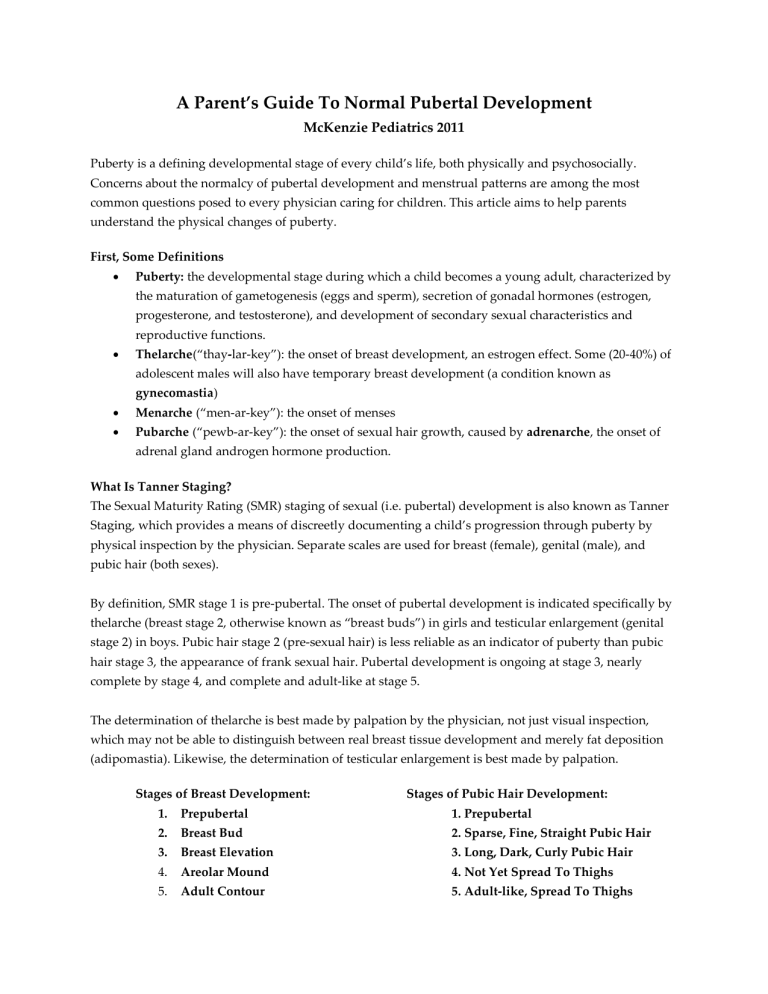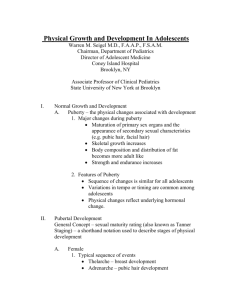Puberty - McKenzie Pediatrics

A Parent’s Guide To Normal Pubertal Development
McKenzie Pediatrics 2011
Puberty is a defining developmental stage of every child’s life, both physically and psychosocially.
Concerns about the normalcy of pubertal development and menstrual patterns are among the most common questions posed to every physician caring for children. This article aims to help parents understand the physical changes of puberty.
First, Some Definitions
Puberty: the developmental stage during which a child becomes a young adult, characterized by the maturation of gametogenesis (eggs and sperm), secretion of gonadal hormones (estrogen, progesterone, and testosterone), and development of secondary sexual characteristics and reproductive functions.
Thelarche(“thay-lar-key”): the onset of breast development, an estrogen effect. Some (20-40%) of adolescent males will also have temporary breast development (a condition known as
gynecomastia)
Menarche (“men-ar-key”): the onset of menses
Pubarche (“pewb-ar-key”): the onset of sexual hair growth, caused by adrenarche, the onset of adrenal gland androgen hormone production.
What Is Tanner Staging?
The Sexual Maturity Rating (SMR) staging of sexual (i.e. pubertal) development is also known as Tanner
Staging, which provides a means of discreetly documenting a child’s progression through puberty by physical inspection by the physician. Separate scales are used for breast (female), genital (male), and pubic hair (both sexes).
By definition, SMR stage 1 is pre-pubertal. The onset of pubertal development is indicated specifically by thelarche (breast stage 2, otherwise known as “breast buds”) in girls and testicular enlargement (genital stage 2) in boys. Pubic hair stage 2 (pre-sexual hair) is less reliable as an indicator of puberty than pubic hair stage 3, the appearance of frank sexual hair. Pubertal development is ongoing at stage 3, nearly complete by stage 4, and complete and adult-like at stage 5.
The determination of thelarche is best made by palpation by the physician, not just visual inspection, which may not be able to distinguish between real breast tissue development and merely fat deposition
(adipomastia). Likewise, the determination of testicular enlargement is best made by palpation.
Stages of Breast Development:
1. Prepubertal
2. Breast Bud
3. Breast Elevation
4. Areolar Mound
5. Adult Contour
Stages of Pubic Hair Development:
1. Prepubertal
2. Sparse, Fine, Straight Pubic Hair
3. Long, Dark, Curly Pubic Hair
4. Not Yet Spread To Thighs
5. Adult-like, Spread To Thighs
What Is The Normal Age of Attainment Of Puberty?
The normal age of onset of puberty is between 8.0 and 13.0 years of age in girls, and between 9.0 and 14.0 years of age in boys.
Thelarche (breast bud development) occurs about 1 year earlier in African-American and Hispanic girls than in non-Hispanic white girls – consequently, breast development is normal during the seventh year in these minority groups, about 15% of whom experience thelarche by 8.0 years of age. Sexual (stage 3) pubic hair, on the other hand, occurs in fewer than 5% of girls younger than 8.0 years of age, regardless of ethnicity.
The trend towards excess adiposity (fat) in children over the past few decades has led to a trend toward earlier age of puberty onset in both boys and girls, by an average of 0.5 years.
What Is The Normal Sequence of Puberty?
For most pre-adolescents and adolescents, the sequence of progression through the pubertal stages is predictable:
Females: female puberty typically begins with thelarche (breast stage 2), which may be asymmetric and ordinarily precedes the onset of pubarche (pubic hair stage 3) by about 1.0 to 1.5 years, though pubarchemay occur first or simultaneously. Menarche occurs approximately 2.5 years (range 0.5 to 3.0 years) after thelarche, at an average age of 12.6 years in white girls and 12.1 years in non-white girls of normal weight. The pubertal growth spurt commences with early puberty, and occurs over 2 to 3 years.
Males: male puberty typically begins with testicular and scrotal enlargement, but no enlargement of the penis (genital stage 2). Most boys then attain pubic hair stage 3 (pubarche) within 1.0 to 1.5 years. The pubertal growth spurt occurs during genital stages 3 (continued growth of the testes and scrotum, and now penis, first in length and later in diameter) and 4 (continued growth of the testes, scrotum, and penis, with enlargement of the glans, or head, of the penis). Further masculinization, including facial hair appearance and voice change, occur during genital stage 4.
What Are Some Normal Variations of Puberty?
Asymmetric breast or testicular development
Gynecomastia (breast tissue development in boys, most often at pubic hair stage 3 to 4, and typically lasting <1 year)
Premature adrenarche/pubarche before age 8 years, which, though often a normal variation, must be assessed by various blood tests to rule out abnormal causes.
How Does Growth Relate To Puberty?
Before puberty, growth velocity decelerates slightly. Production of sex hormones (both estrogen and testosterone) at puberty then accelerates growth. The pubertal growth spurt corresponds more closely to pubertal stage than to chronologic age.
In girls, the pubertal growth spurt begins at breast and pubic hair stage 2. Girls then typically achieve an average peak height velocity of 8.25cm/year at approximately breast and pubic hair stage 3, about 1 year before menarche. Although growth slows after menarche, girls attain an average of another 7cm/year thereafter, and growth is approximately 99% at a bone age of 15 years (which may occur before the chronologic age of 15 years).
The pubertal growth spurt begins an average of 2 years later in boys than girls. Growth accelerates beginning at genital and pubic hair stage 2. Boys achieve an average peak height velocity of 9.5cm/year at genital and pubic hair stages 3 and 4. Growth is approximately 99% complete at a bone age of 17 years, which in some cases occurs before or even after a chronologic age of 17 years.
The Regularly Irregular Menstrual Cycle
More than half of newly menstruating girls experience menstrual irregularity in the first 12-24 months after menarche. Irregular durations, and irregular intervals between menses, are common. By 2 years after menarche, however, less than 10% of girls have cycles less than 21 days or greater than 45 days.
Most girls will experience leucorrhea in the period between 6 to 12 months before menarche. This is the normal and occasional mucous-like vaginal discharge most often noted by the parent who launders the girl’s undergarments. Increased attention should be given during this period to proper hygiene of the vulvar region during bathing so to reduce the risk of secondary urinary tract infections.
Thank you for reading. If you have any further questions, please feel free and encouraged to contact our office!





